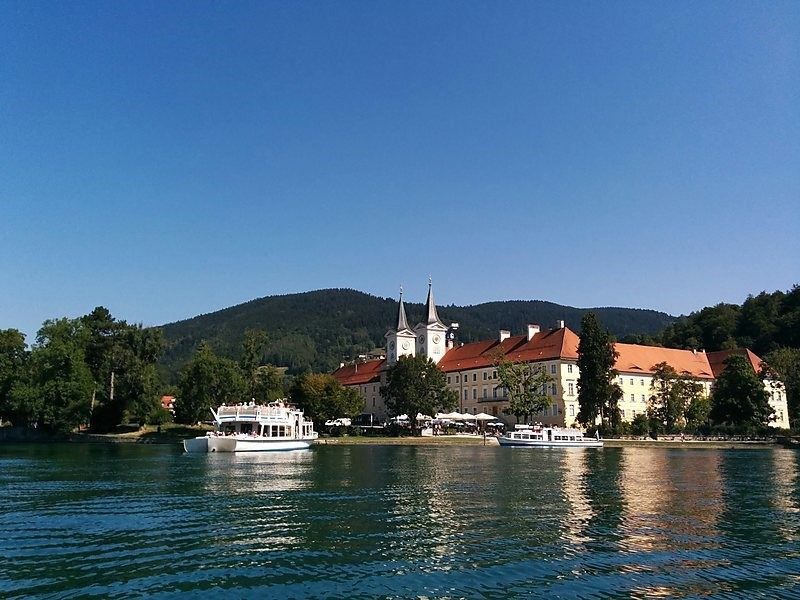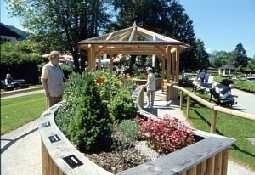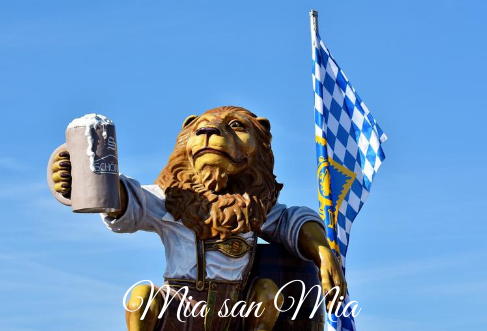About 20,000 years ago , today's Tegernsee valley was created by the advance of a glacier tongue in the Würm Ice Age , the last great ice age in Europe. A basin broke in the glacier located there and filled with water. Today it extends 6.5 kilometers in length and 1.5 kilometers in width and forms the Tegernsee.
Close your eyes and listen - heavenly ....
The country south of Lake Tegernsee was an extremely inhospitable area for many thousands of years. People stayed away from this “ terra incognita ”. The first to roam the thicket must have been brave hunter-gatherers; this is indicated by sparse finds from the Neolithic and Bronze Ages. Early traders came from the south on mule tracks across the Alps.
One of the original paths was a mountain crossing that led in Celtic times from the Inn Valley via today's Brandenburg and the Wild Alm through the Langenau to the Tegernsee and from there further north. To the south, a dark belt of forest stretched along the edge of the Alps. To make it arable and to settle it, people only dared to do that with divine assistance.
And so the development of the Weissach valley , which today houses Kreuth and its districts, is closely linked to the founding of the Tegernsee monastery in the 8th century . On the initiative and supervision of the monastic rulers, extensive clearing activity began from the lake in a southerly direction.
It was ax work with fire that lasted for generations. It lives on in the place name: Kreuth comes from "in the cleared" . Locals from the valley still say "I'm going to Kreith" to this day
Aha! Cool ...
Founder of the monastery "tegarin seo"
The two brothers Oatkar and Adalbert , who belonged to the old Bavarian noble clan of the Huosi , founded a Benedictine monastery on the tegarin-seo (Big Lake) in 746 , like the Tegernsee until the year 1000 AD. was called in old German. The princely founders transferred their rich possessions to the Tegernsee Monastery, which stretched far beyond the Ammersee and formed the basis for the monastery's large estate.
In 1320 the road through the Achental and over the Stubenpass into the Kreuther Tal was opened. A good 120 years later , along with many goods, silver was also transported on this road. The valuable metal traveled to Augsburg from the silver mines in Schwaz, Tyrol , on behalf of the Fuggers .
Under Emperor Otto II , Tegernsee Monastery was made an imperial monastery . A second heyday of the abbey begins, which lasts for more than three centuries and allows the monastery to become a center of illumination . Stained glass and ore casting were also among the crafts practiced in the monastery.

Tegernsee Monastery from the lake
Its economic and political status was not inferior to the cultural significance of Tegernsee. The imperial monastery received imperial privileges and had lower jurisdiction for the area of the Tegernsee valley .
Fragrant medicinal oil
Already in the 15th century monks discovered oil at the Tegernsee . Rock oil bubbled up from the ground on the western shore of Lake Tegernsee. Healing powers were attributed to the petroleum from the St. Quirins spring . And filled in small bottles, the Qurinus oil soon ensured a constant flow of pilgrims and money to the monastery.
Because the crude oil from Tegernsee was not black and stinky, but a yellowish, thin substance that was described as quite fragrant . The petroleum in Tegernsee is said to have smelled aromatic and ethereal . The mineralogist Franz von Kobell describes the smell of the distillate as “like a flower ”.
Unbelievable- 1803: Expropriation of church property by the state (secularization)
In 1746 , Tegernsee celebrated its thousandth anniversary with all the splendor that a baroque monastery could muster.
Half a century later, the Tegernsee monastery no longer existed - in the course of secularisation, the Tegernsee Benedictines were announced on March 17, 1803 that the monastery had been dissolved and the last abbot deposed . The monastery assets were confiscated. The most important works of art and several thousand of the most valuable ones from the library, which last comprised more than 40,000 volumes , went into the state collections.
Secularization robbed the valley of its historical center. For more than 1000 years, the monastery shaped spiritual life, culture and the economy.
A visit by the Bavarian King Max I Joseph and his wife Karoline in 1815 was to usher in a new era. The couple fell in love with the former monastery, bought it on their own account and made it their summer residence.
This was the beginning of an intimate connection that left its mark not only in the Herzogliches Bräustüberl. Culture means as much to the people of Tegernsee as maintaining tradition and customs .
In the 19th century, the Tegernsee valley became the new recreation center for the European nobility . Instead of agriculture, tourism is now one of the main sources of income in the region . Many artists , including the Bavarian writer Ludwig Thoma, are increasingly drawn to Lake Tegernsee.
"Bonzo Lake"
After the end of World War I , the Tegernsee valley quickly developed into one of the centers of the burgeoning National Socialism . During the 1930s, numerous members of the elite loyal to Hitler , including Heinrich Himmler and Max Amman, bought holiday villas on the shores of Lake Tegernsee . Due to its popularity with the wealthy upper class , the lake is given the nickname: "Lago di Bonzo" .
Tegernsee - Long story short…
The Tegernsee is located in southern Germany . It is surrounded by smaller mountains that are about 1500m high . They belong to the Bavarian Alps . Thanks to a ring sewage system around the lake, Tegernsee is now one of the cleanest lakes in Bavaria.
With a maximum depth of almost 73 m , the Tegernsee has a rather elongated shape with a width of up to 1.4 km and a length of 6.5 km . Its area is 9 square kilometers with a volume of over 320 million cubic meters of water. 32.3 billion - that's how many Trag'l (20 x 0.5L) Tegernseer beer would have to be poured into the lake to fill it with beer .
What is there to see?

Fragrance and touch garden in Bad Wiessee
In the Bavarian spa town of Bad Wiessee , the scent and touch garden on the promenade of Lake Tegernsee has been one of the town's major attractions since 2001.
A scent and touch garden like the one in Bad Wiessee aims to appeal to senses other than those of the eyes . Intensely fragrant herbs and flowers as well as plants with a distinctive surface structure were arranged in this roundabout.
In Bad Wiessee, the scent and touch garden has a total of 70 different plants that grow along a defined path. In Braille , but also in Latin letters , it is explained below which plant it is. The sound fountain in the middle of the garden gives visitors an acoustic experience during their visit.
The scent and touch garden was named after Louis Braille . His bust forms the center of the garden and is covered by a small pavilion. It is located in a prominent position on the lake promenade . World Braille Day (January 4th) commemorates the birthday of its inventor.
Incidentally, Louis Braille himself did not live to see the international triumph of his typeface. He died of tuberculosis in 1852 at the age of 43 . It was only 100 years after his death that his home country honored the life's work of Louis Braille and had his bones reburied in the Paris Pantheon - the resting place of France's national heroes.
Louis Braille - Inventor of Braille
Braille is now an indispensable part of everyday life for people with visual impairments . There were six points that were to change the world of blind and visually impaired people in 1825. That year , 16-year-old Louis Braille invented Braille.
Braille is as simple as it is ingenious . It is based on six points: three points in height by two points in width . This results in a total of 64 different possible combinations for displaying letters, characters and numbers. The invention of Braille gave blind people access to education and knowledge in one fell swoop.

Louis Braille

Braille Alphabet
How do you write in Braille ? If you write a text in Braille by hand, you need a stencil and a stylus . The stencil, also called braille board , consists of two parts between which a sheet of paper is clamped. Blind people then have to write the Braille characters mirrored and from right to left . Only then, after turning the paper over, can they read the raised dots in the correct order from left to right.
Scent and touch garden
Seepromenade
83707 Bad Wiessee
